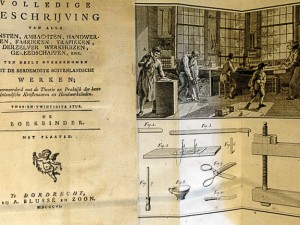 “Time Honored Techniques: Bookbinding Manuals from 1650-1880”, an exhibition of bookbinding manuals from the museum’s collection, reflecting changes in culture and technology, is open at the ABM through January 15, 2015. Exhibition curator Tom Conroy reflects on the use and purpose of the manuals.
“Time Honored Techniques: Bookbinding Manuals from 1650-1880”, an exhibition of bookbinding manuals from the museum’s collection, reflecting changes in culture and technology, is open at the ABM through January 15, 2015. Exhibition curator Tom Conroy reflects on the use and purpose of the manuals.
Many bookbinders say outright “You can’t learn to bind from books.” So what is the use of a manual? The American Bookbinders Museum’s current exhibit of twenty one early bookbinding manuals, written from 1658 to 1880, faces this question directly. Not all of the books we now see as manuals were written to teach binding skills. Rene Dudin’s magnificent folio of 1772 was part of a detailed description of all the crafts, a scientific setting of things in their proper place and proportion. Early English manuals are mostly collections of recipes for dyeing covers or marbling. Eighteenth-century German binders wrote for the instruction of other binders, but elsewhere it was well on in the nineteenth century before there were books meant to teach a reader to bind. All these, with their differing functions, look much alike and read much alike and are collected as manuals.
Some critics would reduce the collecting of manuals to a ceremonial function: they can be shelved for display, lending the binder gravitas and showing clients his knowledge and wisdom. Yet, in the end, manuals are books you read to learn to do things. Some craftsmen cannot learn by reading; some, indeed, cannot be taught by any explanation, written or oral, they must be given a demonstration. However, some binders assuredly can learn by reading. Manuals can teach much of the technique and standards of binding to those with minds to read and hands to work.
Old manuals preserve details, of technique or context, which have changed. They illustrate innovative machines and equipment, as well as aid in identifying them. Manuals, by showing how binders prepared materials, tell us something of the nature and economics of binders’ supplies, and this casts light on the social history of the entire book trade, where binders were poor cousins to the prosperous printers and booksellers. A collection of binding manuals (rare, often printed in tiny editions, with contents sometimes sketchy or ambiguous) is a step toward recovering the nature of bookbinding in the past.
Tom Conroy is a book restorer, fine binder, binding historian, and toolmaker living in Berkeley, California. He has authored many articles, as well as the volume Bookbinders’ Finishing Tool Makers 1780-1965 (Plough Press, 2002) Tom teaches workshops on tool making for bookbinders all over the country.

